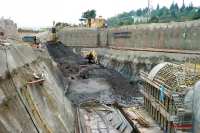Lainz Tunnel, LT 21 Contract Section
Client: High-Performance Railways AG
Development Period: 1990 to 2001
The LT 21 contract section is part of the railway link between the Western, Southern and Donaulände Railway Line in Vienna (Lainz Tunnel). In this section of 300 m, the tunnel structure crosses the Wien valley and the tunnel transitions from a two-track tunnel to two single-track tunnels. The tunnel in this section was built using the cut and cover method, which required deep building pits. Because the Wien River had to be crossed, the construction had to be carried out in two phases, and several retaining structures had to be broken down and later rebuilt.
BGG was commissioned with the supervision of the project regarding the geological, geotechnical and geohydrological consulting from the time the route was chosen until the completion of construction. The results of subsoil explorations were used to compile geotechnical and geohydrological expert's reports. Based on these reports, geomechanical models were developed that were necessary for the calculation of the building pits. During construction, geodetic measuring points were supervised and inclinometer measurements and evaluations were carried out. Consequently, the excavation progress and the securing measures could be managed in an ideal way. Lastly, BGG was commissioned with the geological documentation.
Securing of the building pit towards the existing Western Railway Line:
At the west end of the section, a building pit with a depth of 20 m had to be secured. The building pit was situated at a distance of only 10 m from the existing Western Railway Line. In this area, the subsoil above the tunnel crown consists of artificial deposits with a thickness of several meters and flat-shaped gravel of the Wien River. Underneath the tunnel, the subsoil consists of highly disjoined and fragmented claystone that has a character similar to soil. Due to the close vicinity of the railway tracks, and the disadvantageous subsoil conditions, high safety levels were required in order to minimize the displacements of the securing walls.
Due to the accurate evaluation of the subsoil conditions, this contract section was completed without major problems.
April 2001
